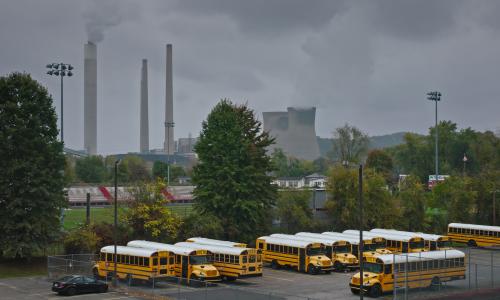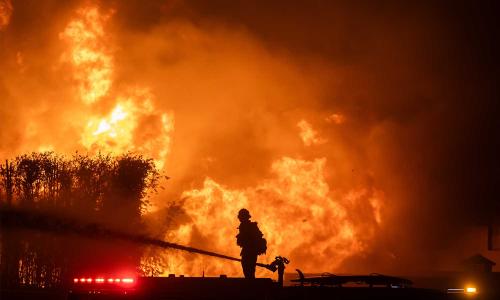Table of Contents
Air pollution occurs when the air contains gases, dust, smoke from fires, or fumes in harmful amounts. Tiny atmospheric particles - aerosols - are a subset of air pollution that are suspended in our atmosphere.
Aerosol can be both solid and liquid. Most are produced by natural processes such as erupting volcanoes, and some are from human industrial and agricultural activities.
Aerosols have a measurable effect on climate change. Light-colored aerosol particles can reflect incoming energy from the sun in cloud-free air and dark particles can absorb it. Over the historic period, the net effect globally was for aerosols to partially offset the rise in global mean surface temperature. Aerosols can modify how much energy clouds reflect and they can change atmospheric circulation patterns.
Aerosol sources, composition, and removal processes
Worldwide, most atmospheric aerosol particles are produced by natural processes such as grinding and erosion of land surfaces resulting in dust, salt-spray formation in oceanic breaking waves, biological decay, forest fires, chemical reactions of atmospheric gases, and volcanic injection.
Some particles, on the other hand, have human origins—industry, agriculture, transport (including aviation), and construction. The composition of atmospheric aerosol particles varies widely depending on their source—they may contain salts (predominantly sulfates), minerals (such as silicon), organic materials, and, in most cases, water.
The particles grow by absorbing water vapor and other gases. In moist air, clouds form when water vapor condenses onto these ‘cloud condensation nuclei’. These then grow into cloud drops, which eventually fall to the surface as rain or snow, depositing the particles on land or in the ocean.
[caption] [/caption]Although dust plumes from the Sahara and Gobi deserts can be seen circling most of the globe in satellite pictures, aerosol particles in the lower troposphere (the lowest layer of the atmosphere, where weather occurs) are usually removed from the atmosphere by settling and precipitation within several days to weeks after they were produced. In the stratosphere (the atmosphere layer above the troposphere), chemical reactions of gases from volcanoes produce sulfate particles that can remain for one or more years, spreading over much of the globe.
Aerosol particles and climate
Although we are familiar with local particulate ‘air pollution’ due to human activities, the fact that atmospheric particles of both natural and human origin have substantial influence on our climate is less widely understood. The particles can play important climatic roles both outside and inside clouds.
In clear air, tiny aerosol particles interact with the solar beam. Particles containing little or no carbon are effectively ‘white.’ They reflect solar radiation, making the air and Earth surface below them a bit cooler than they would otherwise be. Sulfate particles in the stratosphere from the Pinatubo volcanic eruption in 1991, for example, produced measurable cooling for two years over much of the globe. In contrast, particles containing substantial amounts of black carbon (e. g., soot, which is typically produced from combustion of fossil fuels, biofuels, and biomass burning) warm their surroundings by absorbing solar radiation before it reaches the ground. Since black carbon reflects the incoming sunlight, it also acts a shade and the ground surface below becomes cooler.
These tiny particles also create cloud droplets in the lower troposphere. Water droplets and ice particles are basically white, so they reflect solar radiation; on the other hand, the condensed water also traps and emits long wave radiation, producing heat. Thus clouds can have either cooling or warming effects on a local area, depending on the altitude of the cloud and whether the reflecting or trapping effect is strongest.
Because of many unknowns relating to aerosol particles, the magnitude of aerosol impacts is one of the major advancements in understanding that occurred between the fourth and fifth IPCC climate assessments. Particularly noteworthy is the higher confidence regarding aerosol radiation interactions and volcanic aerosols. NASA currently has several aerosol monitoring sites across the world, whose data are used for better understanding of climate and air quality, and for better pollution management.
[caption] Aerosol monitoring network: This figure displays the surface stations where NOAA conducts aerosol measurements.[/caption]How is human-caused air pollution changing our climate?
Human-caused particulate air pollution has a relatively minor—and likely decreasing—impact on our climate.
Aerosol particles of human origin can have a net effect of diminishing the energy that arrives at the Earth’s surface. Scientists estimate that particles produced by human activities have led to a net loss of solar energy (heat) at the ground by as much as 8 percent in densely populated areas over the past few decades. This effect, sometimes referred to as ‘solar dimming,’ may have masked some of the late 20th century global warming due to heat-trapping gases.
Human activities that result in production of both reflecting and absorbing aerosol particle have been curtailed by legislation and modern technology in many places. The ‘pea soup fogs’ that so bedeviled London in Sherlock Holmes’ day, for example, were caused by particles produced by incomplete combustion of coal for heating. These ‘fogs’ in London are now a thing of the past, thanks to mandatory scrubbers and other advanced combustion techniques.
Regional and temporal aerosols trends indicate shifts in regions of influence for aerosols produced from human activities. Haze clouds seen over urban regions give dramatic proof of the effects of human-induced particles in the United States, while atmospheric soot production from burning fossil fuels for energy production is still very high in many parts of Asia, including large clouds of pollution across much of China.
The primary cause of global warming is too much CO2
Global warming is primarily caused by emissions of too much carbon dioxide (CO2) and other heat-trapping gases into the atmosphere when we burn fossil fuels to generate electricity, drive our cars, and power our lives.
These heat-trapping gases spread worldwide and remain in the atmosphere for decades to centuries. Thus, as we continue to emit these gases, their atmospheric concentrations build up over time. In contrast, atmospheric aerosol particles are largely localized near their sources, and do not linger in the atmosphere for long so that, even if we continue to emit them at current rates, their atmospheric concentrations will not build up markedly over time.
The effect of long-lived global warming emissions will far outweigh the cooling effect of short-lived atmospheric particles.
Can climate intervention with aerosols save us from global warming?
Because global warming is such a serious threat, some scientists and engineers have explored the idea of harnessing the reflective power of some aerosol particles to temporarily combat global warming while non fossil fuel energy sources are being more fully developed. Several climate intervention (also-called ‘geoengineering’) strategies for reducing global warming propose using atmospheric aerosol particles to reflect the sun’s energy away from Earth.
The idea is to artificially increase the concentrations of ‘white’ atmospheric aerosol particles above the surface of the ocean and/or in the lower stratosphere (above where weather occurs) in order to reflect more of the sun’s energy away from Earth. The field of climate intervention (still in its infancy), has the potential to buy us some time in the attempt to maintain relatively slow warming rates. Such actions would have large hurdles regarding international governance, and experimentation with our very complex climate system by dramatically increasing reflecting aerosols carries with it the potential for large unintended, and potentially dangerous, side effects on ecosystems, agriculture, and human health. Therefore, any intentional increase in aerosol particles would have to be considered carefully and thoroughly before a possible deployment.
Foremost, because aerosol particles do not stay in the atmosphere for very long—and global warming gases stay in the atmosphere for decades to centuries—accumulated heat-trapping gases will overpower any temporary cooling due to short-lived aerosol particles. Climate intervention is not considered a replacement for the reduction of carbon emissions.



